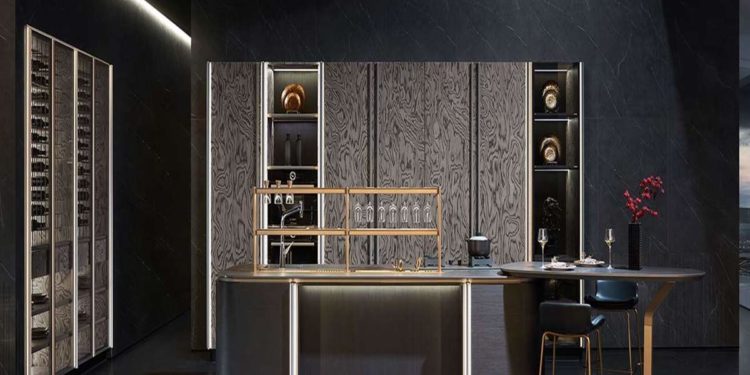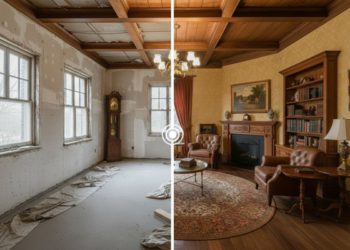When renovating a kitchen or bathroom, the cabinet decision looms large. I’ve spent fifteen years guiding homeowners through this exact choice, and it’s rarely straightforward. Custom or stock? It’s a question that affects your timeline, budget, and ultimate satisfaction with the space.
Understanding the Real Differences
Let’s clarify what we’re actually talking about here. Stock cabinets are pre-manufactured in specific sizes and styles, ready to purchase and install. They’re the cabinet equivalent of off-the-rack clothing. Custom cabinets, conversely, are built specifically for your space according to your exact specifications – the bespoke suit of cabinetry.
What often surprises people is that the visible differences between high-quality stock and custom cabinets can be subtle. Many homeowners expect custom cabinets to look dramatically different, when in reality, the distinctions often lie in construction methods, material quality, and dimensional flexibility rather than obvious visual cues.
The Price Factor: More Complex Than You Think
Yes, custom cabinets generally cost more – typically 30-50% more than comparable stock options. But the calculation isn’t quite as straightforward as comparing sticker prices.
With stock cabinets, you’re limited to standard sizes. This often means using filler strips to accommodate the specific dimensions of your space, potentially wasting valuable storage area. You might also find yourself compromising on certain features or adding aftermarket solutions to achieve the functionality you want.
Custom cabinets maximize every inch of available space and include exactly the features you need, where you need them. This efficiency sometimes justifies the price difference, especially in smaller kitchens where storage is at a premium.
I had clients last year with an awkwardly shaped kitchen that would have required significant fillers with stock cabinets. The custom route actually gave them about 20% more storage capacity, which helped offset the higher cost per cabinet. In their case, paying more actually delivered more.
Timeline Considerations: When Do You Need It Done?
If you’re working with a tight deadline, stock cabinets hold a clear advantage. Most are available within days or weeks, compared to the typical 8-12 week lead time for custom cabinetry. For rental properties or quick flips, this timeline difference alone can decide the matter.
But let’s be real about renovation timelines in general – they almost always take longer than expected. I’ve seen many projects where other delays would have accommodated the custom cabinet timeline anyway. It’s worth considering your overall project schedule realistically before ruling out custom based solely on lead time.
Quality Variations: Not All Cabinets Are Created Equal
The quality spectrum exists in both categories. There are exceptional stock cabinets and disappointing custom ones. However, custom cabinets typically offer:
- Material selection specific to your needs and preferences
- Construction methods focused on durability rather than shipping efficiency
- Hardware options that can be precisely matched to your usage patterns
- Finish application processes that may be more thorough and durable
Stock cabinets have improved dramatically in recent years. Major cabinet franchise operations have incorporated many construction techniques once exclusive to custom shops. The quality gap has narrowed, though distinctions remain in material options, joinery methods, and finish durability.
Customization Beyond Size: The Details Matter
Custom cabinetry offers modifications that go well beyond dimensions:
- Specific internal organization systems designed for your actual items
- Height adjustments that perfectly suit the primary users’ ergonomics
- Integration with unusual architectural features
- Special solutions for unique storage problems
I recently visited the Canton Fair and was fascinated by the innovative storage mechanisms being integrated into both custom and stock cabinets internationally. Some of these features are now making their way into the American market, giving stock cabinet buyers more options than ever before.
Come to think of it, the very definition of “stock” has evolved. Many manufacturers now offer modification options that create a middle ground between truly custom and completely standardized cabinets.
Space Optimization: The Fit Factor
In standard rectangular kitchens with typical ceiling heights, stock cabinets often fit quite well. But introduce soffits, angles, unusual ceiling heights, or existing architectural features you want to preserve, and custom cabinets quickly become more attractive.
Custom cabinets can:
- Extend precisely to your ceiling height
- Accommodate plumbing or electrical elements without wasting space
- Navigate around existing architectural features
- Convert awkward corners into functional storage
The difference is particularly noticeable in older homes with non-standard dimensions or unusual architectural characteristics. Stock cabinets often look obviously retrofitted in these spaces, while custom cabinets can appear as if they were part of the original design.
The Semi-Custom Middle Ground
For many homeowners, semi-custom cabinets offer an appealing compromise. These provide some dimensional flexibility and additional feature options while maintaining more reasonable price points and lead times than fully custom cabinets.
Typical semi-custom options include:
- Limited dimension modifications (usually in 3″ increments)
- More finish and door style choices than stock
- Some internal organization options
- Several construction upgrade possibilities
This middle path often delivers 80% of what most homeowners want from custom cabinets at perhaps 30-40% over stock cabinet pricing.
Resale Value Considerations
Here’s something worth thinking about if you’re renovating with future sale in mind: while quality cabinets generally enhance home value, the premium paid for custom cabinets isn’t always fully recouped at sale time.
Buyers certainly appreciate beautiful, functional cabinetry, but many can’t distinguish between high-end stock and custom cabinets at a glance. The exception might be homes in luxury markets, where buyers expect and value custom details throughout.
For most homeowners planning to sell within 5 years, high-quality stock or semi-custom cabinets often represent the more financially prudent choice.
Who Should Choose Custom Cabinets?
Custom cabinets make the most sense for:
- Homeowners planning to remain in their homes long-term
- Unusual spaces where standard sizes won’t work well
- People with specific functional requirements not met by stock options
- Design-focused renovations where cabinets are a key aesthetic element
- Situations where maximizing every inch of storage is essential
Who Should Choose Stock Cabinets?
Stock cabinets typically work best for:
- Tight renovation timelines
- Investment properties
- Straightforward spaces with standard dimensions
- Homeowners working with limited budgets
- Temporary solutions that may be replaced in a future renovation
Making Your Decision
Beyond all these factors, there’s an emotional component to this decision. Some homeowners simply love knowing their cabinets were crafted specifically for their space. Others prefer the practicality and value orientation of well-chosen stock cabinets.
But don’t be swayed by terminology alone. Always evaluate the actual construction, materials, and functionality rather than just the “custom” or “stock” label. I’ve seen stunning kitchens using primarily stock cabinets with perhaps one or two custom elements in key areas – a hybrid approach that often delivers the best value.
And remember – the perfect cabinets for you are the ones that best suit your specific needs, timeline, and budget, regardless of which category they fall into. The right choice isn’t about bragging rights; it’s about creating a space that functions beautifully for how you actually live.











































































